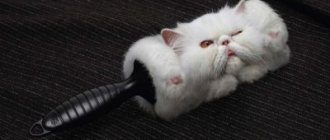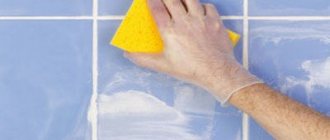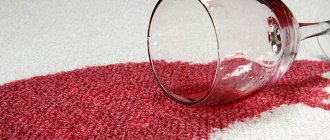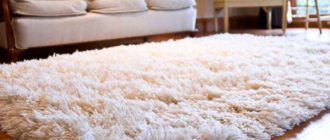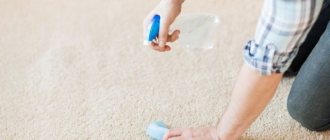Almost everyone probably has the familiar antiseptic, iodine. The main advantages of the product include rapid wound disinfection. But when liquid gets on the carpet, it leaves an obvious unsightly blot. You can remove iodine stains from carpet yourself. In any case, that’s what experienced housewives say. The main thing here is timeliness and the right choice of cleaning product. But you shouldn’t wipe off the blot. It is affected by improvised or professional reagents. If you need safe stain removal, you can find out about this on the carpet dry cleaning page or simply leave a request in the form below.
How to remove a fresh stain?
Iodine, when it gets on a carpet, is quickly absorbed into the fibers. If possible, try to remove the stain immediately.
Procedure:
- Blot the area where the antiseptic gets on the carpet with napkins or towels with good absorbency.
- Quickly mix starch with water until it becomes a paste.
- Apply the mixture to the stain.
- Leave for a quarter of an hour.
- Vacuum the carpet.
If there are stains left after treatment, you can get rid of them using a soap solution, which is prepared as follows:
- rub laundry soap;
- pour a tablespoon of chips into a separate container;
- pour in 1 liter of heated water;
- stir.
The resulting solution is used to wash the carpet from the front and back sides, trying to avoid excessive moisture. If the color is light, then it is better to finish the surface with fresh lemon juice.
The main causes of linoleum contamination
Linoleum most often gets dirty in high-traffic areas, such as the hallway or main room.
Iodine can get onto the floor covering only if the bottle is used carelessly. It can fall right out of your hands, drops can flow from the pipette
Pharmacy and folk remedies will help eliminate their traces. They are always at hand in the house. If you clean the surface immediately, not even the slightest trace will remain on it. You will have to tinker with old blots.
Experts, talking about how to remove stains from linoleum, pay attention to the technical features of the coating. Its front layer is covered with a film of polymers
It increases the wear resistance of the rolled material and can be soft or very hard. In any case, iodine instantly penetrates its structure and completely saturates the protective film. That is why even if you quickly wash off a stain with water, traces of it will still remain on the surface of the material. But if you know what you can use to clean stains on linoleum, you can successfully solve this problem.
How to remove marks from coating at home?
Using preparations that you already have on hand, you can get your carpet in order quickly and without significant financial investments. Pharmaceutical preparations and kitchen products will be used .
Soda and vinegar
The cleaning properties of vinegar and baking soda make it possible to remove brown iodine stains from the surface of the carpet.
Procedure:
- Rub the stained area with soda so that the entire mark is completely covered with powder.
- Pour vinegar directly onto the stain.
- Wait an hour for the reaction to take place.
- Vacuum.
If there is a trace left after treatment, you can use a special shampoo for cleaning carpets.
Ammonia
For processing, prepare an aqueous solution:
- pour a glass of water into the container;
- add 1 tbsp. l. ammonia;
- stir;
- the mixture is applied to the mark;
- leave for 20 minutes;
- washed away.
A specific unpleasant odor requires very good ventilation.
Acetone
Acetone-containing products, such as nail polish remover, can dissolve the iodine pigment. The stain is treated with a cotton swab soaked in solvent . After 5 minutes, wash the affected area of the carpet with soapy water.
Hydrogen peroxide
The pharmaceutical product is poured directly from the bottle onto the area with the stain. If the carpet pile is long, it is convenient to use a tampon or sponge. This will allow you to properly treat the affected area. After a few minutes, the composition is washed off with soapy water.
If the contamination does not go away after the first treatment, the procedure can be repeated as many times as necessary. In this case, each stage should be completed by washing the stain with a soap solution.
Sodium thiosulfate
Sodium thiosulfate is a chemical that can be used to remove stains from light-colored carpet. A concentrated aqueous solution of powder is used for processing.
Preparation of a solution to remove fresh small stains:
- Pour 1 glass of water into the prepared container.
- Add 1 tsp. drug.
- Stir.
Preparation of a solution to remove old and/or extensive stains:
- pour ½ cup of water into a container;
- add 1 tsp. drug;
- mix.
Soak a napkin or rag with the resulting product and begin to scrub the stain from the edges to the center. The treatment is completed by rinsing with clean water. If you need to clean several times, then after each scrubbing with a cleaning composition, its residues must be washed off.
Alcohol
Pharmaceutical alcohol can be used as a solvent to remove iodine from carpet. It is applied in its pure form and washed off after 10-15 minutes. At the end of cleaning, rinse with water.
Causes of carpet contamination
If you do not remove a stain on the carpet immediately, it will be more difficult to do so later. Any carpet inevitably gets dirty, because people constantly walk on it, spill liquids, and drop food.
The most common types of pollution:
- dirt and sand;
- dust;
- chemicals or medications;
- fats and technical oils;
- food and drinks;
- hair and animal fur;
- urine from children and pets;
- paint and resin.
You can scrub off complex stains only after determining the composition of the stains. The main thing is to choose the right detergent.
Going to dry cleaning
In cases where you are not sure that you will be able to remove the stain without consequences, you can use dry cleaning services. You can find a company specializing in carpet cleaning on the Internet using the search query “carpet cleaning company” and additionally specifying the name of your city.
It is better to give preference to those companies that have been in the service provision market for a long time and have positive reviews from their clientele. Information about this can also be found on the Internet.
Most companies in the city provide services with a specialist visiting the address. The cost of treatment is based on the type and composition of the coating, as well as the size of the carpet.
In the capital, the average cost of cleaning synthetic flooring is 200 rubles per 1 m² , and wool flooring is 250 rubles per 1 m². If the pile is long, then maintenance will cost more - about 400 rubles per 1 m².
If the composition of the carpet is complex, combining several types of materials, as well as cotton, viscose or silk, then processing will have a higher cost - about 800 rubles per 1 m². Many companies set a limit on the minimum order amount, for example, from 2,000 rubles. After professional treatment, not only stains are eliminated, but also a comprehensive treatment is carried out.
Carpet dry cleaning and stain removal can be done at home or taken away.
Useful tips
- If you have tried all the above methods, but some part of the stain still remains, do not worry, the iodine solution tends to evaporate, which means that after a few months the stain may disappear without a trace.
- If a real oriental rug is contaminated with iodine, you should contact a dry cleaner, because... Such carpets, as a rule, have a delicate structure and are easily damaged.
- Never blow dry your carpet. This may lead to a change in its structure.
- When using any of the above methods, you should always try the solution on an inconspicuous area of the carpet to avoid damaging it.
Prohibitions when deleting
In the process of removing iodine stains from the carpet, it is important to remember the following prohibitions:
To clean the surface, you should not use aggressive agents - serious chemical solvents, as this will increase the likelihood of damage to the structure and color of the material.- Do not use intense mechanical action - this can harm the carpet itself.
- It is contraindicated to use bleach for carpet cleaning, as the result will be unpredictable even on a light-colored carpet.
- Do not pour several thinners at the same time, especially chlorine, soda and vinegar. When mixed, such drugs form harmful volatile substances. In addition, the “explosive mixture” can damage the fibers and cause patterns to discolor.
What are the dangers of self-purification of iodine?
If you don’t want to take your carpet to the dry cleaner (you don’t have time, you don’t know who to trust), then it is important to remember that treating stains yourself can lead to the following consequences:
- Damage to the thread structure when trying to wash the product. This is especially true for those carpets that cannot be wet cleaned (silk, wool, leather, jute, etc.). From such an impact the palace loses its shape.
- Burnout of colors. When making different types of rugs, factories (craftsmen) use certain types of dyes, which can form an unexpected reaction with the cleaning agent used. As a result, the iodine will leave, but the place of contamination will still leave its faded mark.
- Lack of reaction, stain spreading across the coating. This is the best result of home cleaning from iodine. But the fiber or brightness of the colors will not be damaged when trying to wash the coating.
- Poor drying of long-pile rugs and, as a result, mold growth inside the woven structure. The fungus tends to provoke allergic reactions. Especially in children.
- Shrinkage of the carpet and damage to the fiber structure when diligently drying the product with a hairdryer. This cannot be done at all. Parts of the product that have been soaked in water and then dried with a hairdryer tend to shrink significantly. This is especially true for thin lint-free rugs.
Sodium thiosulfate
Thiosulfate is essentially a medicine that can be purchased in pharmacies. But it can be used not only in treatment, but also in the fight against iodine stains in particular.
For this purpose, it is necessary to dilute thiosulfate (about a teaspoon) with water (about 1/3 of the container). Generously soak a thick cloth or sponge in the diluted mixture and, starting from the edges, gently rub the contaminated section of the carpet until the iodine trace disappears. Remove any remaining solution ingredients with a wet cloth. Finally, treat the surface with soap and rinse with water. Then dry it.
Felt pen
Children love to use markers. And often a fun time ends with the appearance of stains both on clothes and on the carpet. The means at hand will help you get rid of contaminants: solvent, soap, powder, alcohol.
- Alcohol-containing products will help remove stains. Use eau de toilette, cologne or vodka. Dampen a rag with one of the indicated products and treat the damaged area;
- If the stain is old, you can wash it with a solvent. Use gasoline, acetone or white spirit. Apply any of the following products to a cotton pad and clean the stain. Upon completion of cleaning, treat the area cleared of the felt-tip pen with a sponge and carpet cleaner;
- A special anti-stain soap will also help get rid of dirt. It can be used to remove marker stains from any type of fabric. Wipe the area with soap and rinse with water
- Find a marker remover at an office supply store. It is produced in the form of a spray. Apply to the desired area and rinse with water.
We use peroxide and alcohol
On light-colored carpets, dried iodine traces can be easily destroyed with peroxide. Pour the product over the contaminated area on both sides. A violent reaction will immediately occur. When the foam stops raging, take the household items. soap, rub it on a soft-bristle brush and carefully walk over the carpet. Collect the yellow foam with a rag, pour peroxide again, and clean with soap. After these steps, wash the coating. There should be no traces of iodine left on it.
- If you need a reliable remedy to remove iodine stains on the carpet, dissolve 1 tbsp. l. soda in a quarter glass of peroxide.
- Saturate the lint with cleaning liquid, being careful not to go beyond the contours of the dirt. Rub gently with a microfiber cloth and rinse the stained area after 30 minutes.
High-proof alcohol and any substances that include it in its composition help to cope with the problem. The treated stain should be left for 15 minutes before rinsing with water.
Precautionary measures
In order not to spoil the carpet, before using any method, you need to conduct an experiment on an inconspicuous piece. To protect the skin of your hands, it is recommended to wear gloves . To dry the water faster, you can use a fan.
Read also: How to properly store medals and orders
After cleaning is completed, be sure to remove any remaining products used to remove the stain. Traces of brilliant green and iodine should be removed immediately , since old stains are much more difficult to remove.
Even tough stains can be cleaned, but it's easier when they're fresh. If brilliant green or iodine is spilled on the carpet in the first minutes, you can quickly fix everything, and the product will retain its original appearance. If you follow the correct sequence of actions, not a trace will remain of the stain.
How to remove iodine from clothes using household chemicals
Thanks to household chemicals, you can quickly remove iodine from white or colored clothes. Today, the most popular option, which can be used to remove not only iodine, but also other types of stains, is Vanish. The product must be used according to the attached instructions.
In addition, choosing a stain remover would be an excellent solution. The usage algorithm is as follows:
- The solution is prepared according to the instructions supplied by the manufacturer.
- Place clothes in the solution.
- Maintain for some time.
- They wash it.
When choosing a product, you should pay special attention to the composition; it must be suitable for a specific type of fabric.
Lemon juice
It is better to use this method when removing stains from carpets with light prints. Because this fruit has the skill to lighten dark textures.
- Squeeze the juice from the lemon pulp.
- After moistening the fabric or cotton material in the citrus liquid, generously soak the edges and then the middle of the problem area of the carpet with it.
- Leave the juice on the surface for up to half an hour, and then, without using detergents or cleaning agents, rinse the pile with water.
- Dry with a hairdryer.


